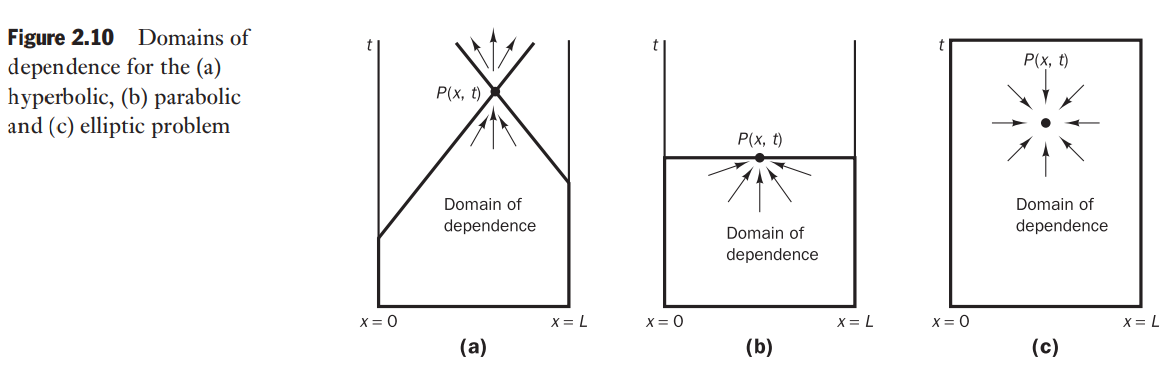CFD-FVM-02: Classification of Physical Behaviours

First we distinguish two principal categories of physical behaviour:
- Equilibrium problems
- Marching problems
Equilibrium problems
These and many other steady state problems are governed by elliptic equations. The prototype elliptic equation is Laplace’s equation, which describes irrotational flow of an incompressible fluid and steady state conductive heat transfer. In two dimensions we have
A very simple example of heat conduction:

This problem is one-dimensional and governed by the equation
Problems requiring data over the entire boundary are called boundary-value problems
Disturbance signals travel in all directions through the interior solution for elliptic equations. Consequently, the solutions to physical problems described by elliptic equations are always smooth even if the boundary conditions are discontinuous.
Marching problems
These problems are governed by parabolic or hyperbolic equations.
Parabolic equations
Parabolic equations describe time-dependent problems involving significant amounts of diffusion. The prototype parabolic equation is the diffusion equation

Initial conditions are needed in the entire rod and conditions on all its boundaries are required for all times
. This type of problem is termed an initial–boundary-value problem.
The steady state is reached as time
Hyperbolic equations
The prototype hyperbolic equation is the wave equation
It will be shown that disturbances at a point can only influence a limited region in space. The speed of disturbance propagation through an hyperbolic problem is finite and equal to the wave speed c. In contrast, parabolic and elliptic models assume infinite propagation speeds.
The role of characteristics in hyperbolic equations

The way in which changes at one point affect events at other points depends on whether a physical problem represents a steady state or a transient phenomenon and whether the propagation speed of disturbances is finite or infinite.
Summary
| Problem type | Equation type | Prototype equation | Conditions | Solution domain | Sol. smoothness |
|---|---|---|---|---|---|
| Equilibrium problems |
Eliptic | Boundary conditions |
Closed domain | Always smooth | |
| Marching problems with dissipation |
Parabolic | Initial and boundary conditions |
Open domain | Always smooth | |
| Marching problem without dissipation |
Hyperbolic | Initial and boundary conditions |
Open domain | May be disconti- nuous |
Classification method for simple PDEs
A practical method of classifying PDEs is developed for a general secondorder PDE in two co-ordinates
The classification of a PDE is governed by the behaviour of its highestorder derivatives, so we need only consider the second-order derivatives.
By looking at the characteristic equation
Simple wave solutions occur if the characteristic equation below has two real roots:
| Equation type | Characteristics | |
|---|---|---|
| Hyperbolic | Two real characteristics | |
| Parabolic | One real characteristic | |
| Elliptic | No characteristics |
when
Given
Fletcher (1991) explains that the equation can be classified on the basis of the eigenvalues of a matrix with entries
- if any eigenvalue
: the equation is parabolic - if all eigenvalues
and they are all of the same sign: the equation is elliptic - if all eigenvalues
and all but one are of the same sign: the equation is hyperbolic
Classification of fluid flow equations
| Steady flow | Unsteady flow | |
|---|---|---|
| Viscous flow | Elliptic | Parabolic |
| Inviscid flow | Hyperbolic | |
| Thin shear layers | Parabolic | Parabolic |
For practical problems, the type might be mixed. Such flows may contain shockwave discontinuities and regions of subsonic (elliptic) flow and supersonic (hyperbolic) flow, whose exact locations are not
known a priori.

Auxiliary conditions for viscous fluid flow equations
Boundary conditions for compressible viscous flow
- Initial conditions for unsteady flows:
- Everywhere in the solution region
, and must be given at time .
- Everywhere in the solution region
- Boundary conditions for unsteady and steady flows:
- On sold walls:
(no-slip condition) (fixed temperature) or (fixed heat flux)
- On fluid boundaries:
- inlet:
, and must known as a function of position - outlet:
and (stress continuity)
- inlet:
- On sold walls:
In the table subscripts
Outflow condition
- specified pressure
Symmetry boundary condition:
Cyclic boundary condition: